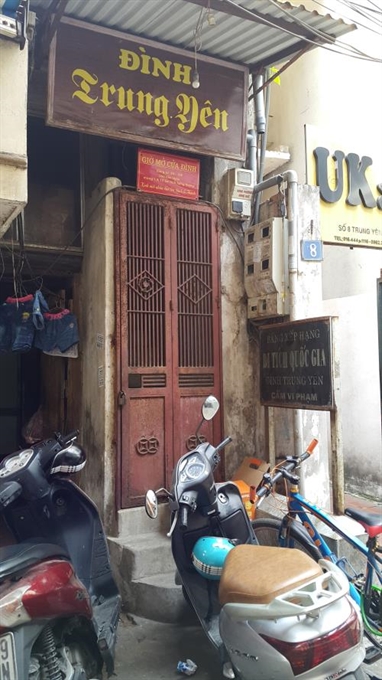 Society
Society

Thousands of residents living next to or in proximity to historic relics in Hà Nội are waiting for relocation following plans to restore the sites while local authorities are still trying to find solutions amid a lack of finance and land funding.
 |
| Trung Yên temple in Hoàn Kiếm District, Hà Nội. — Photo bnews.vn |
HÀ NỘI — Thousands of residents living next to or in proximity to historic relics in Hà Nội are waiting for relocation following plans to restore the sites while local authorities are still trying to find solutions amid a lack of finance and land funding.
Hà Nội has a dense network of historic relics but the high population density at historic sites has badly affected the space and landscape around these relics as well as hindered the protection and restoration efforts of local people.
According to figures from the municipal Department of Culture and Sport, up to 166 historic relics in the capital city share space with over 1,200 households.
Đồng Quang pagoda in Đống Đa District, for example, is surrounded by 16 households while the group of Quang Hoa-Thiền Quang-Pháp Hoa pagodas in Hai Bà Trưng District is jostles for space amongst more than 40 households.
The situation has existed since the 1960s. Many people returned to Hà Nội after migrating to other regions to work in the middle of last century and moved close to pagodas or temples as a result of land scarcity. The inhabitants became even more crowded when people living near the Hồng (Red river) Delta escaped flooding and resettled near historic relics in the 1970s.
An additional factor that is not mentioned is that a number of schools and headquarters of People’s Committees of some wards are located in the precinct of historic relics due to the lack of land.
The inhabitants, however, have affected the landscape around historical relics and caused difficulties for relevant agencies in preserving and restoring these relics. Many ancient structural buildings are being invaded by tea shops, food stalls, living quarters and vehicles. It is hard for people to find Hà Vỹ temple in Hoàn Kiếm District, whose entrance gate is being almost covered by a house. Meanwhile, its yard is used by some food stalls to keep tables, chairs and cooking utensils.
Vũ An Toàn, who takes care of the temple, said it was difficult for people to enter the temple because of the narrow entrance. “I asked owners of these food stalls many times to tidy up their belongings but it still happens again,” he said.
Deputy director of the municipal Department of Culture and Sport, Trương Minh Tiến, said the municipal authorities had directed relevant agencies to zone off and relocate these households for many years but the situation had yet to be improved due to the huge amount of residents needing to be relocated.
According to the Hà Nội Historical Relic Management Board, the city has relocated residents at 21 relics and invested in restoring these relics.
Hoàn Kiếm District relocated ten households from Đông Thành temple in the Old Quarter in 2012 and invested VNĐ15 billion (US$672,000) in restoring and upgrading the temple.
Vice chairman of the district People’s Committee, Phạm Tuấn Long, said the district had relocated 200 households with 1,000 residents at 10 historical relics since 2008.
However, thousands of residents still needed to be relocated from historical relics in the capital city. Inner districts of Hà Nội started the relocation task 10 years ago but they had so far only relocated residents from 20 out of 166 historic relics.
Not only local authorities, but many residents also want to move away from historical relics because of poor living conditions.
Lê Thị Ngoãn, a member of one of seven households living in the precinct of Liên Phái pagoda in Hai Bà Trưng District, said her five-member family had lived for 25 years in a three-storey house with each storey having a total area of 4 sq.m.
“It is too tight. Not only my family, but other households also wish to be relocated soon,” she said.
Lê Thị Thanh Vi, who lives under Trung Yên Temple in Hoàn Kiếm District, said her family had to live in a small house of several sq.m without space to hang the washing and they even had to share a toilet with other households. “We want to move out of here as soon as possible,” she said.
However, the key problem is the lack of finance and land funds. The city budget is not enough to meet real demand. It costs around VNĐ1.5 billion ($67,200) for the relocation of each household, according to Long from Hoàn Kiếm District.
Phạm Thị Hiền, head of the Culture and Information Bureau of Hai Bà Trưng District, said apart from the district budget, many pagodas had to mobilise capital themselves to help households relocate.
Deputy director of the municipal Department of Culture and Sport, Trương Minh Tiến, said the relocation depended on budget and land fund of each district. The city would gradually relocate these households to protect and restore historical relics but it would take time due to limited capacity, he said. — VNS